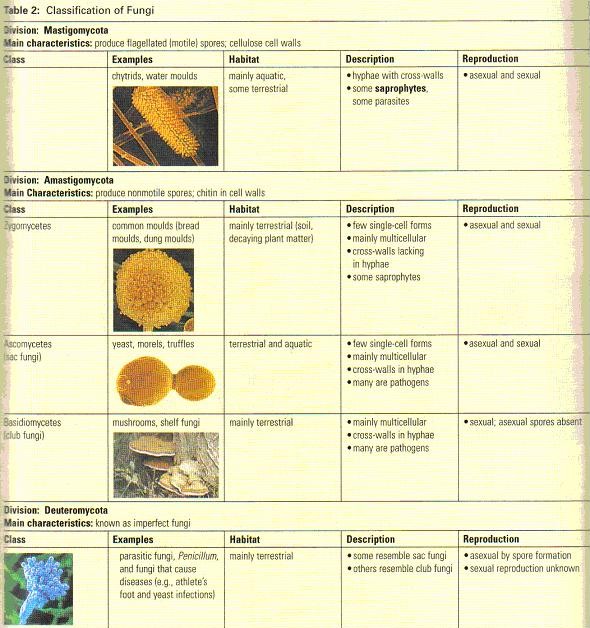|
General Characteristics
Fungi
- most are multicellular
- all are heterotrophs
- reproduce sexually and asexually
- most are terrestrial

PHYLUM
1. basidiomycetes - Any of various members of a large group of fungi bearing sexually produced spores on a basidium
2. ascomycetes - Any of various members of a large group of fungi characterized by the presence of sexually produced spores formed within an ascus
3. zygomycetes - A subclass of fungi characterized by sexual reproduction resulting in the formation of a large multinucleate spore formed by union of similar gametes
Plantae
- all are multicellular
- all are autotrophs
- reproduce sexually and asexually
- most are terrestrial

PHYLUM
1. angiosperms - a plant whose ovules are enclosed in an ovary; a flowering plant
2. pteridophyta - a class of flowerless plants
3. gymnosperms - a plant whose seeds are not enclosed within an ovary (cone bearing plants).
4. tracheophytes - vascular plants, including seed plants and ferns, having a conducting system of xylem and phloem.
5. bryophyta - a division of nonflowering plants characterized by rhizoids rather than true roots and having little or no organized vascular tissue and showing alternation of generations between gamete-bearing forms and spore-bearing forms
|
|
KINDGOM FUNGI - Anatomical and Physiological Characteristics
- Their life cycle is complete when the organism
 produces the next generation. produces the next generation.
- There are different life cycles - asexually and sexually reproduction which produce spores no matter what.
o Spores have a haploid number chromosome number and are produced in specialized structures called sporangia.
o Spores are dispersed by air currents.
- Fragmentation can also occur which is breaking apart of portions of the mycelium
 Vital because of their decomposing capabilities which recycle complex organic substances into usable raw materials Vital because of their decomposing capabilities which recycle complex organic substances into usable raw materials- Yeast (fungi) is used to make bread, wine, and beer.
- Penicillium produces an antibiotic.
- Aspergillus is used to flavour soft drinks.
- Mushrooms, morels, and truffles are food delicacies.
- Decompose harmful pollutants.
- Have symbiotic relationships with other organisms which benefit both parents or are necessary for the survival of both partners.

- Fungi may have symbiotic relationships with plant roots to form mycorrhizae.
o In mycorrhizae, fungal hyphae help the plant absorb nutrients; the plant shares its carbohydrates with the fungas.
- Fungi may have symbiotic relationships with cynanobacteria or green algae to form lichens.
o In lichens, fungal mycelia provide structural support and carbon dioxide and water to the autotrophic partner; the autotrophic partner shares carbohydrates it has manufactured with fungi.
-
Lichens are important in natural succession
Kingdom Plantae - Anatomical and Physiological Characteristics
- As plants began to survive on la
 nd, they altered the conditions by slowly creating soil and microclimates. Plants provided food for animals that were also evolving systems to cope with terrestrial life. nd, they altered the conditions by slowly creating soil and microclimates. Plants provided food for animals that were also evolving systems to cope with terrestrial life.
- Some plant modifications.
o Supportive structures - stems and roots/rhizoids
o Anchoring structures - roots/rhizoids
o Transport systems to carry nutrients and water - vascular system
o Means to reduce water loss - cuticle
o Means to regulate gas exchange and reduce water loss - stomata
o Reproductive strategies for dry conditions - spores, pollen, nectar, colourful flowers, fruit, and seeds
 Have a life cycle in which a haploid form (gametophyte) alternates with a diploid form (sporophyte). A.K.A an “alternation of generations” Have a life cycle in which a haploid form (gametophyte) alternates with a diploid form (sporophyte). A.K.A an “alternation of generations”
o Gametophytes produce gametes
o Sporophytes are the result of the union of 2 gametes
- Some cells of the sporophyte undergo meiosis to produce haploid cells.
- Each spore develops into a haploid gametophyte.
Back to the Top
|

Classification of the different Fungi |
